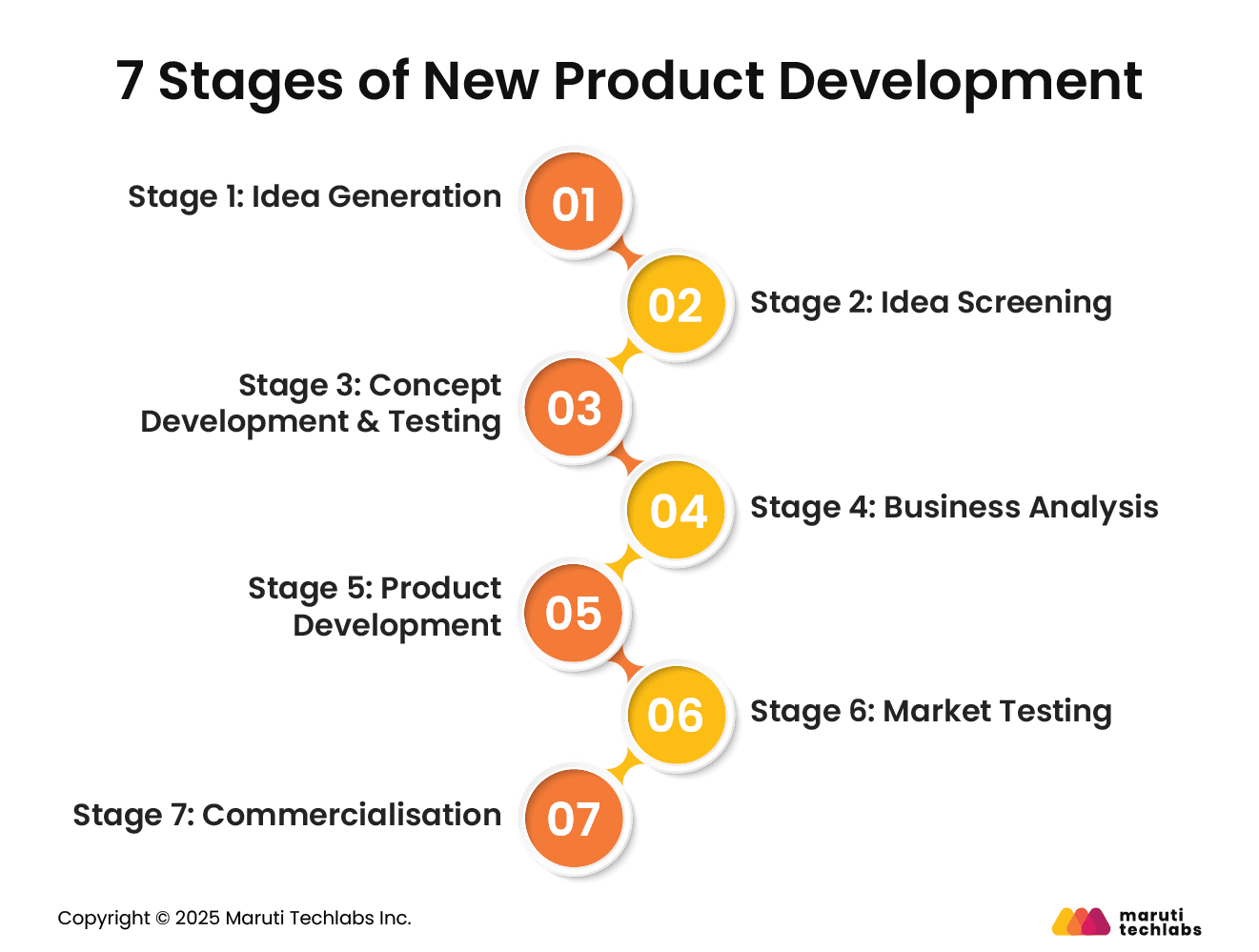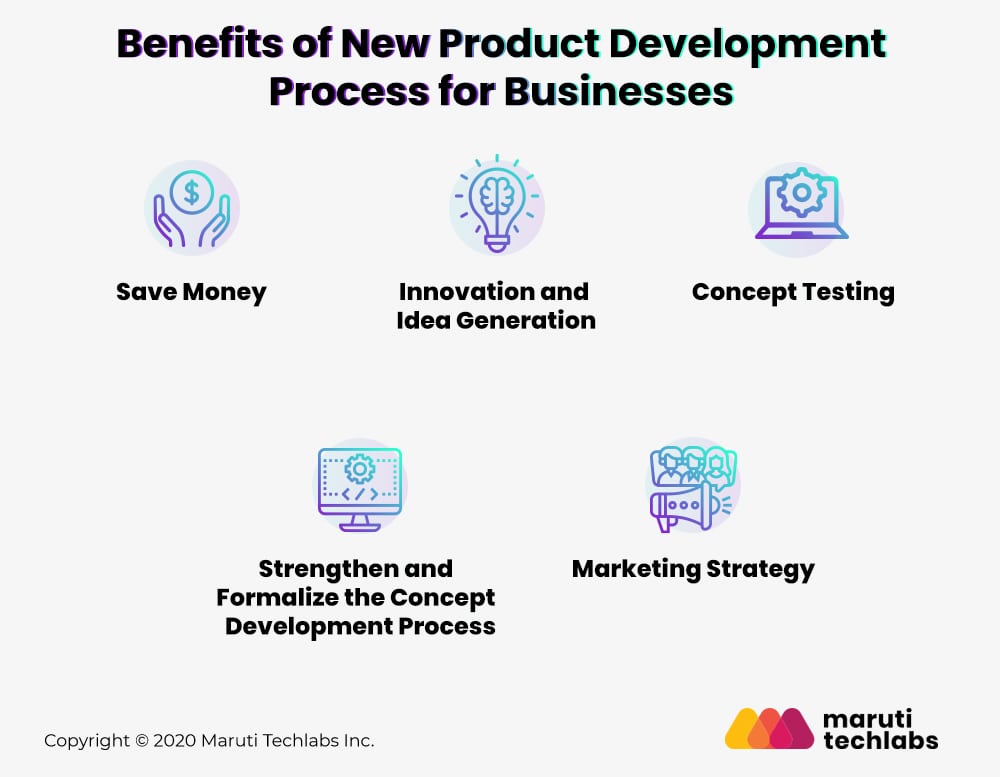

New Product Development Process: Steps, Benefits, Best Practices






“Product development is the end-to-end process of bringing a new idea to market. It involves researching user needs, designing innovative solutions, developing the product, testing and launching it commercially to address customer problems or market gaps.”
Hey there! This blog is almost about 3900+ words long & not everyone likes to read that much. We understand that.
This is precisely why we made a podcast on the topic. Mitul Makadia, CEO & Founder of Maruti Techlabs, talks to Bikshita Bhattacharyya about his Agile implementation, strategy, and process during the nascent stages of the company.
He walks us through the challenges he faced, how the business benefited from scaling Agile, and how important is the scrum master in making Agile a success at the organizational level. Here is a small snippet from that episode. Check it out!
In this guide, we will look in depth at the new product development process (NPD) and its marketing strategies to bring your idea from concept to market in a short turnaround time.
The New Product Development (NPD) process is a structured framework that guides businesses from ideation to market launch. It ensures a product idea is validated, refined, and aligned with market demands before full-scale investment.
The process typically includes seven stages namely idea generation, screening, concept development, business analysis, product development, market testing, and commercialization.
Each phase plays a critical role in minimizing risks, ensuring product-market fit, and driving innovation. Companies use this framework to launch successful products that meet customer needs, stay competitive, and optimize resources through disciplined planning, prototyping, and feedback loops.
Agile and Lean methodologies have redefined product development, especially for digital products. Instead of following the traditional linear model, Agile breaks down the product lifecycle into short, iterative sprints.
This enables teams to release working versions quickly and adapt based on real-time feedback. Lean focuses on maximizing value while minimizing waste, encouraging early validation through MVPs and continuous experimentation.
When applied to the NPD process, Agile and Lean streamline collaboration between design, development, and business units.
For example, with the above discuss micro-learning app, instead of fully developing the product in Stage 5, Agile teams deploy a minimum viable version and improve it in weekly cycles, reducing time-to-market and improving product-market fit.
The New Product Development (NPD) process helps transform raw ideas into market-ready solutions through a disciplined and iterative approach.
Whether you're building a SaaS tool, a consumer product, or an AI-based platform, these seven stages offer a structured path to reduce risk and improve your chances of success.
Let's break down each stage with its objective, key activities, and tools illustrated through an example of developing a language learning mobile app.

Objective: Discover innovative product ideas based on user pain points, market trends, or business goals.
Activities: Brainstorming, competitor analysis, customer feedback.
Tools Used: Design thinking workshops, mind mapping tools.
Example: An edtech startup gathers data showing a rising demand for micro-learning apps for busy professionals.
Objective: Eliminate low-potential ideas and retain the most viable ones.
Activities: Prioritizing ideas based on feasibility, market demand, and ROI.
Tools Used: Idea scoring matrix, feasibility analysis.
Example: Among three ideas, the micro-learning language app is selected for its wide appeal and scalable business model.
Objective: Develop detailed product concepts and validate them with target users.
Activities: Create mockups, define key features, conduct user interviews.
Tools Used: Storyboarding, clickable prototypes, feedback surveys.
Example: A mock version of the app is shown to professionals in the 25–40 age group for usability feedback.
Objective: Evaluate the financial and strategic viability of the product.
Activities: Estimate costs, revenue potential, and breakeven point.
Tools Used: Market sizing tools, cost-revenue modeling.
Example: The app’s freemium model is projected to convert 8% of users to paid subscriptions in year one.
Objective: Turn the validated concept into a working prototype or MVP.
Activities: Code development, UI design, backend setup.
Tools Used: Agile tools, version control, CI/CD pipelines.
Example: The team develops an MVP with 5 languages, daily lessons, spaced repetition, and basic gamification..
Objective: Test the product with a limited audience to validate functionality and market response.
Activities: Launch beta version, track metrics, gather feedback.
Tools Used: A/B testing tools, app analytics.
Example: The MVP is released to 500 users in India and Germany; retention and feedback are monitored closely.
Objective: Launch the product at scale and monitor performance.
Activities: Execute go-to-market strategy, enable customer support, gather post-launch data.
Tools Used: CRM systems, app store optimization, marketing automation.
Example: The app is launched globally with social media campaigns and corporate tie-ins for employee language training.
To gain an edge over your competitors, you must learn about your product's sustainability in light of current market needs and its economic relevance. Such intricate insights into new product development can be best obtained by seeking assistance from a product strategy consulting service.
Here are some of the ways using which you can help your business with the benefits of new product development:

According to a report by Fundera, it is estimated that around 20% of the new businesses fail in the first year. This is due to factors such as improper market research, incompetence, and economically viable business models. The new product development process is designed to eliminate these risks from your business by testing the potential of your idea and the current market situation.
Identifying the effectiveness of the new products in the NPD process before they get released in the market enables you to adapt your idea according to the market needs or withdraw it entirely to save your time and money. Having this information with you can help as a secret weapon to launch a disastrous business idea and keep your business financially stable for a long time.
The new product development process is the promoter and driver of new ideas for your business. Having a framework to test your new product’s viability will naturally lead to its implementation. Developing and nurturing a culture of innovation is crucial to the commercial growth of the business and its staff.
Just like a new business, you need to properly define your product concept at the beginning of the new product development life cycle. It must be done by considering the anticipated consumer, and hence you must describe the product in meaningful consumer terms.
The common steps to be followed are:
You can streamline your business by laying off these frameworks and boosting staff productivity. It is a natural step to consider before concept testing in the new product development process.
The above-mentioned concept development process is best paired with the concept testing process. Once the idea is finalized, it is necessary to test it against the market condition and target it.
It is done by testing the target consumer by market research practices. It would consist of presenting a physical representation of the product to the consumer. The picture or the description of words is often sufficient, but the better results are observed from the authentic physical representation.
After presenting the concept to consumers, you can ask for responses and engage with them in the product discussion. The responses in this discussion are used as assets to improve the product and consumer experience.
The new product development process can help with marketing strategies for your product.It is a natural course of action once your concept has been designed and tested. With the intel you collected in the development phase, you can turn this into a marketing strategy. This process is then simplified and accelerated. The three critical areas of your marketing strategy include:
Here are the top 4 challenges observed with new product development.
Understanding whether a new product truly meets customer needs is challenging. Poorly defined target audiences or assumptions about demand can lead to failed launches and wasted investments, especially in fast-changing markets.
Some product ideas may be desirable but difficult to implement due to tech limitations, integration issues, or platform constraints. These risks often surface in late development stages, increasing costs and time.
Unexpected feature changes, scope, or lack of planning can lead to inflated development costs. Without regular monitoring and phase-wise budgeting, teams risk overspending and reducing ROI.
When business, tech, and design stakeholders are not aligned on vision, priorities, or metrics, development can slow down or derail. Continuous communication and shared goals are critical for a smooth process.
Most businesses repeatedly deliver successful products to the market even though all their specific approaches vary from each other. Following are some of the best practices to follow for the new product development process:
1. Identify the needs of the target audience.
2. Use the market research and consumer feedback for the product effectively.
3. Communicate across your company for more knowledgeable feedback and insights.
4. Make use of available frameworks for the new product development process. Never develop a new product without a system in place first.
5. Validate your product concept soon in the NPD cycle. For some products, it might include the “soft launch” in which you test the product in small parts before full-scale market release.
6. Invite your cross-functional team into the brainstorming and ideation stage. Great insights for your market can come from everywhere.
7. Set realistic development timelines
8. Concentrate on the ideas your company has both the resources and the expertise to execute.
Did you find the video snippet on What did Mitul’s journey to becoming the CEO of Maruti Techlabs look like? to be insightful? We have a ~22 min video where Mitul Makadia gets into the weeds, and we discuss about Implementing & Scaling Agile to streamline Software Development. Take a look-
To boost efficiency and success rates in product development, companies should focus on early validation, collaboration, and rapid iterations.
Use surveys, interviews, and in-app analytics at each stage to capture user insights. Feedback-driven development ensures your product evolves with real user needs and increases market relevance post-launch.
Build minimum viable products to test core functionalities with real users. This helps reduce development waste, refine value propositions, and gain market feedback before investing in full-scale builds.
Involve product managers, designers, engineers, and marketers early. Cross-functional collaboration accelerates decision-making, balances user desirability with feasibility, and ensures that every feature aligns with business goals.
Telemedicine App Development Example:
Product development is an intricate journey, encompassing ideation, research, design, prototyping, testing, and launch. Each stage presents unique challenges, from securing funding and managing scope creep to ensuring market fit and user adoption.
Offering a compelling value proposition and continuous iteration are key. A holistic approach, integrating user feedback and business goals throughout, is crucial for success in today's dynamic market.
The product development process in almost all cases offer unanticipated challenges that force businesses to shut down their product or service ideas.
Therefore, business should consider partnering with IT outsourcing companies like Maruti Techlabs for product development. This partnership helps them leverage specialized expertise, accelerate time-to-market, reduce operational costs, and gain access to a wider talent pool.
This strategic move allows internal teams to focus on core competencies while ensuring high-quality product delivery. Ready to transform your ideas into reality? Explore our comprehensive Software Product Engineering Services today and build the future, now.
Have questions or need a personalized solution? Contact us today to discuss your project and discover how we can help.
Here are 8 key stages of new product development
Here are 6 steps that you can follow to learn if your idea is viable for development.
Here are the 6 essentials of a product development plan.
You can follow these 6 steps to conduct market research for a new product.
Below are the most common pitfalls you can avoid with product development.
You can try the 6 below-mentioned ways to collect customer feedback.
Prototyping helps you explore the design and functionality of your product by creating its interactive and tangible version.
You can try the steps below to manage costs and the budget for product development effectively.


